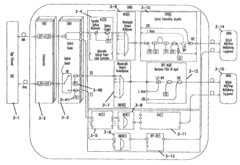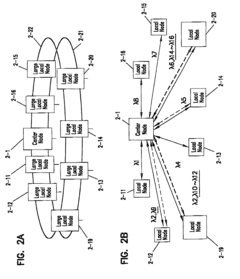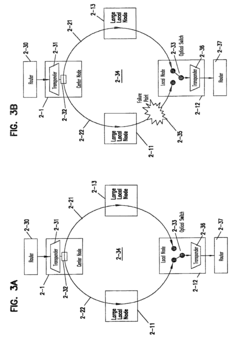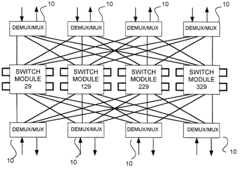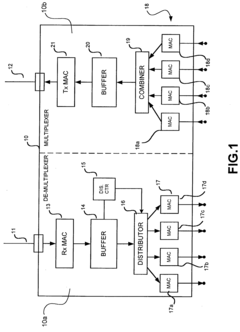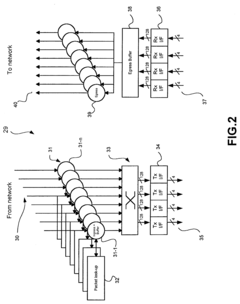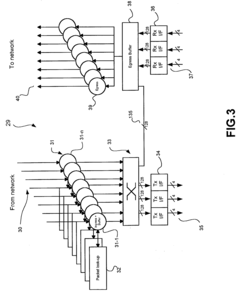Multiplexer Architectures: Revolutionizing Network Infrastructure
JUL 13, 20259 MIN READ
Generate Your Research Report Instantly with AI Agent
Patsnap Eureka helps you evaluate technical feasibility & market potential.
Multiplexer Evolution
The evolution of multiplexer architectures has been a cornerstone in the advancement of network infrastructure. Initially developed in the 1960s, multiplexers have undergone significant transformations to meet the ever-increasing demands of data transmission and network efficiency.
In the early stages, time-division multiplexing (TDM) dominated the field, allowing multiple data streams to share a single communication channel by allocating time slots to each stream. This technology laid the foundation for efficient use of network resources and paved the way for digital telephony systems.
The 1970s and 1980s saw the emergence of frequency-division multiplexing (FDM), which enabled simultaneous transmission of multiple signals over a single medium by assigning different frequency bands to each signal. This innovation greatly expanded the capacity of communication channels, particularly in radio and television broadcasting.
As digital technologies advanced, wavelength-division multiplexing (WDM) came to the forefront in the 1990s. WDM revolutionized optical fiber communications by allowing multiple optical carrier signals to be transmitted on a single optical fiber by using different wavelengths of laser light. This breakthrough dramatically increased the bandwidth and capacity of fiber optic networks.
The turn of the millennium brought about the development of dense wavelength-division multiplexing (DWDM), which further refined WDM technology by packing even more channels into the same fiber, significantly boosting network capacity and enabling the rapid growth of internet infrastructure.
In recent years, the focus has shifted towards more flexible and programmable multiplexing architectures. Software-defined networking (SDN) and network function virtualization (NFV) have introduced new paradigms in multiplexer design, allowing for dynamic allocation of network resources and on-demand service provisioning.
The latest advancements in multiplexer architectures include the integration of artificial intelligence and machine learning algorithms. These technologies enable predictive maintenance, adaptive routing, and real-time optimization of network performance, further enhancing the efficiency and reliability of network infrastructure.
Looking ahead, the evolution of multiplexer architectures is expected to continue with the development of quantum multiplexing techniques, which promise to leverage the principles of quantum mechanics to achieve unprecedented levels of data transmission capacity and security in future network infrastructures.
In the early stages, time-division multiplexing (TDM) dominated the field, allowing multiple data streams to share a single communication channel by allocating time slots to each stream. This technology laid the foundation for efficient use of network resources and paved the way for digital telephony systems.
The 1970s and 1980s saw the emergence of frequency-division multiplexing (FDM), which enabled simultaneous transmission of multiple signals over a single medium by assigning different frequency bands to each signal. This innovation greatly expanded the capacity of communication channels, particularly in radio and television broadcasting.
As digital technologies advanced, wavelength-division multiplexing (WDM) came to the forefront in the 1990s. WDM revolutionized optical fiber communications by allowing multiple optical carrier signals to be transmitted on a single optical fiber by using different wavelengths of laser light. This breakthrough dramatically increased the bandwidth and capacity of fiber optic networks.
The turn of the millennium brought about the development of dense wavelength-division multiplexing (DWDM), which further refined WDM technology by packing even more channels into the same fiber, significantly boosting network capacity and enabling the rapid growth of internet infrastructure.
In recent years, the focus has shifted towards more flexible and programmable multiplexing architectures. Software-defined networking (SDN) and network function virtualization (NFV) have introduced new paradigms in multiplexer design, allowing for dynamic allocation of network resources and on-demand service provisioning.
The latest advancements in multiplexer architectures include the integration of artificial intelligence and machine learning algorithms. These technologies enable predictive maintenance, adaptive routing, and real-time optimization of network performance, further enhancing the efficiency and reliability of network infrastructure.
Looking ahead, the evolution of multiplexer architectures is expected to continue with the development of quantum multiplexing techniques, which promise to leverage the principles of quantum mechanics to achieve unprecedented levels of data transmission capacity and security in future network infrastructures.
Network Demand Analysis
The demand for advanced network infrastructure continues to grow exponentially, driven by the increasing complexity and volume of data traffic. As businesses and consumers rely more heavily on digital services, the need for efficient, high-capacity networks has become paramount. This surge in demand is particularly evident in sectors such as cloud computing, 5G telecommunications, and Internet of Things (IoT) applications.
The global network equipment market, which includes multiplexers and related technologies, is experiencing significant growth. Industry reports indicate that the market is expected to reach substantial valuations in the coming years, with a compound annual growth rate (CAGR) outpacing many other technology sectors. This growth is fueled by the ongoing digital transformation across industries and the need for robust, scalable network solutions.
One of the key drivers of demand for multiplexer architectures is the push for network optimization and efficiency. As data centers and telecommunications providers strive to handle ever-increasing traffic loads, there is a growing emphasis on technologies that can maximize bandwidth utilization and reduce latency. Multiplexers play a crucial role in this optimization by enabling the simultaneous transmission of multiple data streams over a single communication channel.
The advent of 5G networks has further accelerated the demand for advanced multiplexing solutions. The high-bandwidth, low-latency requirements of 5G necessitate sophisticated network architectures capable of handling diverse traffic types and ensuring quality of service. Multiplexers are essential components in meeting these demanding specifications, contributing to the overall performance and reliability of 5G infrastructure.
In the enterprise sector, the shift towards cloud-based services and distributed computing models has intensified the need for flexible and scalable network solutions. Businesses are increasingly adopting software-defined networking (SDN) and network function virtualization (NFV) approaches, which rely heavily on advanced multiplexing techniques to dynamically allocate network resources and optimize traffic flow.
The IoT ecosystem presents another significant market opportunity for multiplexer architectures. As billions of connected devices generate vast amounts of data, there is a growing demand for efficient data aggregation and transmission solutions. Multiplexers enable the consolidation of multiple data streams from various IoT sensors and devices, facilitating more effective data management and analysis.
Environmental concerns and energy efficiency requirements are also shaping the demand for next-generation network infrastructure. There is a growing emphasis on developing multiplexer architectures that not only enhance network performance but also reduce power consumption and physical footprint. This trend aligns with broader sustainability initiatives across the technology sector and presents opportunities for innovation in green networking solutions.
The global network equipment market, which includes multiplexers and related technologies, is experiencing significant growth. Industry reports indicate that the market is expected to reach substantial valuations in the coming years, with a compound annual growth rate (CAGR) outpacing many other technology sectors. This growth is fueled by the ongoing digital transformation across industries and the need for robust, scalable network solutions.
One of the key drivers of demand for multiplexer architectures is the push for network optimization and efficiency. As data centers and telecommunications providers strive to handle ever-increasing traffic loads, there is a growing emphasis on technologies that can maximize bandwidth utilization and reduce latency. Multiplexers play a crucial role in this optimization by enabling the simultaneous transmission of multiple data streams over a single communication channel.
The advent of 5G networks has further accelerated the demand for advanced multiplexing solutions. The high-bandwidth, low-latency requirements of 5G necessitate sophisticated network architectures capable of handling diverse traffic types and ensuring quality of service. Multiplexers are essential components in meeting these demanding specifications, contributing to the overall performance and reliability of 5G infrastructure.
In the enterprise sector, the shift towards cloud-based services and distributed computing models has intensified the need for flexible and scalable network solutions. Businesses are increasingly adopting software-defined networking (SDN) and network function virtualization (NFV) approaches, which rely heavily on advanced multiplexing techniques to dynamically allocate network resources and optimize traffic flow.
The IoT ecosystem presents another significant market opportunity for multiplexer architectures. As billions of connected devices generate vast amounts of data, there is a growing demand for efficient data aggregation and transmission solutions. Multiplexers enable the consolidation of multiple data streams from various IoT sensors and devices, facilitating more effective data management and analysis.
Environmental concerns and energy efficiency requirements are also shaping the demand for next-generation network infrastructure. There is a growing emphasis on developing multiplexer architectures that not only enhance network performance but also reduce power consumption and physical footprint. This trend aligns with broader sustainability initiatives across the technology sector and presents opportunities for innovation in green networking solutions.
Multiplexer Challenges
Multiplexer architectures face several significant challenges as they continue to revolutionize network infrastructure. One of the primary obstacles is the increasing demand for higher bandwidth and data rates. As network traffic grows exponentially, multiplexers must handle ever-larger volumes of data while maintaining low latency and high reliability. This requires continuous innovation in both hardware and software components to keep pace with the evolving needs of modern networks.
Another critical challenge is the complexity of managing and optimizing multiplexer performance in dynamic network environments. Network conditions can change rapidly, and multiplexers must adapt in real-time to maintain optimal data flow. This necessitates sophisticated algorithms and control mechanisms to efficiently allocate resources and prioritize traffic based on varying network conditions and quality of service requirements.
Power consumption and heat dissipation present ongoing challenges for multiplexer architectures, particularly in high-density deployments. As data centers and network infrastructure continue to scale, energy efficiency becomes increasingly crucial. Designers must balance the need for higher performance with the imperative to minimize power usage and thermal output, often requiring innovative cooling solutions and power management techniques.
The integration of multiplexers with emerging technologies such as software-defined networking (SDN) and network function virtualization (NFV) poses additional challenges. These paradigm shifts demand more flexible and programmable multiplexer architectures that can adapt to rapidly changing network configurations and service requirements. Ensuring seamless interoperability and compatibility with diverse network elements and protocols adds further complexity to multiplexer design and implementation.
Security concerns also present significant challenges for multiplexer architectures. As critical components of network infrastructure, multiplexers must incorporate robust security features to protect against unauthorized access, data breaches, and other cyber threats. This includes implementing encryption, access control mechanisms, and monitoring capabilities without compromising performance or introducing unacceptable latency.
Lastly, the need for backward compatibility and future-proofing multiplexer architectures presents ongoing challenges. As networks evolve, multiplexers must support legacy systems while simultaneously accommodating emerging standards and technologies. This balancing act requires careful design considerations and modular architectures that can be upgraded or reconfigured without disrupting existing network operations.
Another critical challenge is the complexity of managing and optimizing multiplexer performance in dynamic network environments. Network conditions can change rapidly, and multiplexers must adapt in real-time to maintain optimal data flow. This necessitates sophisticated algorithms and control mechanisms to efficiently allocate resources and prioritize traffic based on varying network conditions and quality of service requirements.
Power consumption and heat dissipation present ongoing challenges for multiplexer architectures, particularly in high-density deployments. As data centers and network infrastructure continue to scale, energy efficiency becomes increasingly crucial. Designers must balance the need for higher performance with the imperative to minimize power usage and thermal output, often requiring innovative cooling solutions and power management techniques.
The integration of multiplexers with emerging technologies such as software-defined networking (SDN) and network function virtualization (NFV) poses additional challenges. These paradigm shifts demand more flexible and programmable multiplexer architectures that can adapt to rapidly changing network configurations and service requirements. Ensuring seamless interoperability and compatibility with diverse network elements and protocols adds further complexity to multiplexer design and implementation.
Security concerns also present significant challenges for multiplexer architectures. As critical components of network infrastructure, multiplexers must incorporate robust security features to protect against unauthorized access, data breaches, and other cyber threats. This includes implementing encryption, access control mechanisms, and monitoring capabilities without compromising performance or introducing unacceptable latency.
Lastly, the need for backward compatibility and future-proofing multiplexer architectures presents ongoing challenges. As networks evolve, multiplexers must support legacy systems while simultaneously accommodating emerging standards and technologies. This balancing act requires careful design considerations and modular architectures that can be upgraded or reconfigured without disrupting existing network operations.
Current MUX Solutions
01 Network multiplexing and switching architectures
This category focuses on advanced multiplexing and switching architectures for network infrastructure. These designs aim to improve data transmission efficiency, reduce latency, and enhance overall network performance. The architectures may include software-defined networking (SDN) concepts, intelligent routing algorithms, and dynamic resource allocation mechanisms.- Network multiplexing and switching architectures: This category focuses on advanced multiplexing and switching architectures for network infrastructure. These designs aim to improve data transmission efficiency, reduce latency, and enhance overall network performance. The architectures may include intelligent routing algorithms, dynamic bandwidth allocation, and adaptive switching mechanisms to optimize network resource utilization.
- Software-defined networking (SDN) for multiplexer control: Software-defined networking approaches are applied to control and manage multiplexer architectures in network infrastructure. This allows for greater flexibility, programmability, and centralized management of network resources. SDN-based multiplexer control can enable dynamic reconfiguration of network paths, improved traffic management, and enhanced network security.
- Multiplexer designs for 5G and beyond networks: This category covers multiplexer architectures specifically designed for 5G and future generation networks. These designs address the unique requirements of high-bandwidth, low-latency communications in next-generation wireless networks. The architectures may incorporate advanced beamforming techniques, massive MIMO support, and efficient spectrum utilization methods.
- Energy-efficient multiplexer architectures: Energy-efficient designs for multiplexer architectures in network infrastructure are explored in this category. These approaches aim to reduce power consumption while maintaining high performance. Techniques may include adaptive power management, sleep modes for inactive components, and optimized circuit designs to minimize energy loss.
- AI-driven multiplexer optimization: This category focuses on the application of artificial intelligence and machine learning techniques to optimize multiplexer architectures in network infrastructure. AI-driven approaches can enable adaptive traffic management, predictive maintenance, and automated network optimization. These systems can learn from network patterns to improve routing decisions and resource allocation dynamically.
02 Multiplexer designs for wireless communication systems
This point covers multiplexer architectures specifically tailored for wireless communication networks. These designs address challenges such as spectrum efficiency, multi-user access, and interference management in mobile and cellular networks. The architectures may incorporate advanced antenna systems, beamforming techniques, and adaptive modulation schemes.Expand Specific Solutions03 Optical multiplexing techniques for high-speed networks
This category explores multiplexer architectures for optical networks, focusing on techniques like wavelength division multiplexing (WDM) and optical time-division multiplexing (OTDM). These approaches aim to maximize bandwidth utilization in fiber-optic communication systems, enabling ultra-high-speed data transmission for next-generation network infrastructure.Expand Specific Solutions04 Multiplexer designs for network security and encryption
This point addresses multiplexer architectures that incorporate security features and encryption capabilities. These designs aim to protect data transmission within network infrastructure, implementing techniques such as secure key exchange, traffic obfuscation, and hardware-based encryption to enhance overall network security.Expand Specific Solutions05 Adaptive and reconfigurable multiplexer architectures
This category focuses on flexible and reconfigurable multiplexer designs that can adapt to changing network conditions and requirements. These architectures may employ machine learning algorithms, software-defined radio techniques, or field-programmable gate arrays (FPGAs) to dynamically optimize network performance and resource allocation based on real-time traffic patterns and user demands.Expand Specific Solutions
Key Industry Players
The multiplexer architecture market is in a growth phase, driven by increasing demand for efficient network infrastructure. The global market size is expanding rapidly, with projections indicating substantial growth in the coming years. Technologically, multiplexer architectures are evolving, with companies like Qualcomm, Huawei, and NEC leading innovation. These firms are developing advanced solutions to address the growing complexity of network traffic. While established players like Cisco and IBM continue to dominate, emerging companies are introducing disruptive technologies, fostering a competitive landscape. The technology's maturity varies across different applications, with some areas reaching maturity while others are still in early development stages.
QUALCOMM, Inc.
Technical Solution: Qualcomm has developed advanced multiplexer architectures primarily focused on wireless communication systems, particularly in the context of 5G and beyond. Their solution incorporates innovative antenna designs and beamforming techniques to enhance spectral efficiency and network capacity[1]. Qualcomm's multiplexers utilize their proprietary signal processing algorithms to optimize MIMO performance in both sub-6 GHz and mmWave frequency bands. The architecture includes support for dynamic spectrum sharing and carrier aggregation, enabling seamless coexistence of multiple radio access technologies[2]. Qualcomm's multiplexers also integrate with their mobile platform solutions, providing end-to-end optimization for mobile devices and infrastructure equipment. Their architecture incorporates AI-driven predictive algorithms for network resource allocation and interference management[3].
Strengths: Strong expertise in wireless technologies, integration with mobile platforms, and advanced signal processing capabilities. Weaknesses: Limited presence in fixed-line network infrastructure compared to traditional telecom equipment vendors.
Huawei Technologies Co., Ltd.
Technical Solution: Huawei has developed advanced multiplexer architectures for 5G networks, utilizing Massive MIMO technology. Their solution incorporates intelligent beamforming and multi-user MIMO techniques to significantly increase network capacity and spectral efficiency[1]. Huawei's multiplexers employ adaptive modulation and coding schemes, dynamically adjusting to channel conditions for optimal performance. They have also implemented advanced signal processing algorithms to mitigate interference and enhance signal quality in dense urban environments[2]. Huawei's multiplexer architecture integrates seamlessly with their end-to-end 5G network solutions, providing a cohesive and scalable infrastructure for next-generation communications[3].
Strengths: Comprehensive end-to-end solution, advanced signal processing, and integration with 5G technology. Weaknesses: Potential security concerns and geopolitical challenges in some markets.
Core MUX Innovations
Optical network
PatentInactiveUS7302176B2
Innovation
- The implementation of a wavelength division multiplexing optical network with redundant paths, optical switches, and add/drop multiplexers in a ring or star configuration, using low-cost C-band components and optical amplifiers to manage signal failures and expand capacity dynamically, while avoiding four-wave mixing through unequal wavelength spacing.
High-speed switch architecture
PatentActiveUS20040151195A1
Innovation
- A versatile switch architecture that allows mesh links to be looped back to drive the transmitting section of the same module, combined with demultiplexer/multiplexer units connected to all switch modules, ensuring even distribution of traffic and increasing transmission bandwidth by reducing module-to-module traffic through mesh links.
Regulatory Landscape
The regulatory landscape surrounding multiplexer architectures in network infrastructure is complex and evolving, reflecting the critical role these technologies play in modern telecommunications and data transmission systems. Governments and international bodies have recognized the importance of multiplexer technologies in enabling efficient and high-capacity network operations, leading to the development of various regulatory frameworks.
In many jurisdictions, the deployment and operation of multiplexer systems are subject to telecommunications regulations. These regulations often focus on ensuring fair competition, maintaining service quality, and protecting consumer interests. Regulatory bodies such as the Federal Communications Commission (FCC) in the United States and the Body of European Regulators for Electronic Communications (BEREC) in Europe have established guidelines for the use of multiplexing technologies in network infrastructure.
One key aspect of the regulatory landscape is spectrum allocation and management. As multiplexer architectures enable more efficient use of available bandwidth, regulators have had to adapt their policies to accommodate these advancements. This has led to the reallocation of frequency bands and the introduction of dynamic spectrum access techniques, which allow for more flexible and efficient use of the radio spectrum.
Interoperability standards have also become a significant focus of regulatory efforts. Organizations such as the International Telecommunication Union (ITU) and the Institute of Electrical and Electronics Engineers (IEEE) have developed standards for multiplexer architectures to ensure compatibility between different vendors' equipment and seamless integration into existing network infrastructures. Compliance with these standards is often mandated by regulatory authorities to promote market competition and prevent vendor lock-in.
Data privacy and security regulations have increasingly impacted the design and implementation of multiplexer systems. With the growing concern over data protection, regulators have imposed strict requirements on network operators to ensure the confidentiality and integrity of data transmitted through multiplexed channels. This has led to the development of advanced encryption and security protocols specifically tailored for multiplexer architectures.
Environmental regulations have also begun to influence the multiplexer landscape. As network infrastructure continues to expand, energy efficiency has become a key consideration. Regulators in many countries have introduced guidelines and incentives to promote the adoption of energy-efficient multiplexer technologies, aiming to reduce the overall carbon footprint of telecommunications networks.
The regulatory landscape for multiplexer architectures is not static, and it continues to evolve in response to technological advancements and changing market dynamics. As new multiplexing techniques emerge, such as those leveraging artificial intelligence and machine learning, regulators are working to develop frameworks that can accommodate these innovations while maintaining a balance between fostering technological progress and protecting public interests.
In many jurisdictions, the deployment and operation of multiplexer systems are subject to telecommunications regulations. These regulations often focus on ensuring fair competition, maintaining service quality, and protecting consumer interests. Regulatory bodies such as the Federal Communications Commission (FCC) in the United States and the Body of European Regulators for Electronic Communications (BEREC) in Europe have established guidelines for the use of multiplexing technologies in network infrastructure.
One key aspect of the regulatory landscape is spectrum allocation and management. As multiplexer architectures enable more efficient use of available bandwidth, regulators have had to adapt their policies to accommodate these advancements. This has led to the reallocation of frequency bands and the introduction of dynamic spectrum access techniques, which allow for more flexible and efficient use of the radio spectrum.
Interoperability standards have also become a significant focus of regulatory efforts. Organizations such as the International Telecommunication Union (ITU) and the Institute of Electrical and Electronics Engineers (IEEE) have developed standards for multiplexer architectures to ensure compatibility between different vendors' equipment and seamless integration into existing network infrastructures. Compliance with these standards is often mandated by regulatory authorities to promote market competition and prevent vendor lock-in.
Data privacy and security regulations have increasingly impacted the design and implementation of multiplexer systems. With the growing concern over data protection, regulators have imposed strict requirements on network operators to ensure the confidentiality and integrity of data transmitted through multiplexed channels. This has led to the development of advanced encryption and security protocols specifically tailored for multiplexer architectures.
Environmental regulations have also begun to influence the multiplexer landscape. As network infrastructure continues to expand, energy efficiency has become a key consideration. Regulators in many countries have introduced guidelines and incentives to promote the adoption of energy-efficient multiplexer technologies, aiming to reduce the overall carbon footprint of telecommunications networks.
The regulatory landscape for multiplexer architectures is not static, and it continues to evolve in response to technological advancements and changing market dynamics. As new multiplexing techniques emerge, such as those leveraging artificial intelligence and machine learning, regulators are working to develop frameworks that can accommodate these innovations while maintaining a balance between fostering technological progress and protecting public interests.
Energy Efficiency Impact
The impact of multiplexer architectures on energy efficiency in network infrastructure is significant and multifaceted. As data traffic continues to grow exponentially, the need for more energy-efficient networking solutions becomes increasingly critical. Multiplexer architectures play a crucial role in addressing this challenge by optimizing the utilization of network resources and reducing power consumption.
One of the primary ways multiplexer architectures contribute to energy efficiency is through improved traffic management. By efficiently combining multiple input signals into a single output stream, multiplexers reduce the number of active components required in network devices. This consolidation leads to a decrease in overall power consumption, as fewer individual components need to be powered and cooled.
Advanced multiplexer designs also incorporate intelligent power management features. These systems can dynamically adjust their operating parameters based on traffic load and network conditions. During periods of low traffic, certain components or entire sections of the multiplexer can be put into low-power modes or even completely shut down, significantly reducing energy consumption without compromising network performance.
The integration of wavelength division multiplexing (WDM) technology in optical networks has further enhanced energy efficiency. WDM multiplexers allow multiple data streams to be transmitted simultaneously over a single optical fiber, dramatically increasing the capacity of existing infrastructure without proportionally increasing power consumption. This approach not only reduces the energy required per bit of data transmitted but also minimizes the need for additional physical infrastructure.
Moreover, the development of software-defined networking (SDN) compatible multiplexer architectures has opened up new possibilities for energy optimization. SDN allows for centralized control and management of network resources, enabling more efficient routing and traffic distribution. This capability can lead to better utilization of network capacity and reduced energy waste from idle or underutilized components.
The energy efficiency gains from advanced multiplexer architectures extend beyond individual devices to impact the entire network ecosystem. By enabling more efficient use of existing infrastructure, these technologies reduce the need for frequent network upgrades and expansions. This not only saves energy in the operation of network equipment but also in the manufacturing and deployment of new hardware.
As network operators and service providers face increasing pressure to reduce their carbon footprint, the role of energy-efficient multiplexer architectures becomes even more critical. These technologies are essential in meeting sustainability goals while supporting the growing demand for high-bandwidth, low-latency network services. The ongoing research and development in this field promise to deliver even more significant energy savings in future network infrastructures, contributing to a more sustainable digital ecosystem.
One of the primary ways multiplexer architectures contribute to energy efficiency is through improved traffic management. By efficiently combining multiple input signals into a single output stream, multiplexers reduce the number of active components required in network devices. This consolidation leads to a decrease in overall power consumption, as fewer individual components need to be powered and cooled.
Advanced multiplexer designs also incorporate intelligent power management features. These systems can dynamically adjust their operating parameters based on traffic load and network conditions. During periods of low traffic, certain components or entire sections of the multiplexer can be put into low-power modes or even completely shut down, significantly reducing energy consumption without compromising network performance.
The integration of wavelength division multiplexing (WDM) technology in optical networks has further enhanced energy efficiency. WDM multiplexers allow multiple data streams to be transmitted simultaneously over a single optical fiber, dramatically increasing the capacity of existing infrastructure without proportionally increasing power consumption. This approach not only reduces the energy required per bit of data transmitted but also minimizes the need for additional physical infrastructure.
Moreover, the development of software-defined networking (SDN) compatible multiplexer architectures has opened up new possibilities for energy optimization. SDN allows for centralized control and management of network resources, enabling more efficient routing and traffic distribution. This capability can lead to better utilization of network capacity and reduced energy waste from idle or underutilized components.
The energy efficiency gains from advanced multiplexer architectures extend beyond individual devices to impact the entire network ecosystem. By enabling more efficient use of existing infrastructure, these technologies reduce the need for frequent network upgrades and expansions. This not only saves energy in the operation of network equipment but also in the manufacturing and deployment of new hardware.
As network operators and service providers face increasing pressure to reduce their carbon footprint, the role of energy-efficient multiplexer architectures becomes even more critical. These technologies are essential in meeting sustainability goals while supporting the growing demand for high-bandwidth, low-latency network services. The ongoing research and development in this field promise to deliver even more significant energy savings in future network infrastructures, contributing to a more sustainable digital ecosystem.
Unlock deeper insights with Patsnap Eureka Quick Research — get a full tech report to explore trends and direct your research. Try now!
Generate Your Research Report Instantly with AI Agent
Supercharge your innovation with Patsnap Eureka AI Agent Platform!
